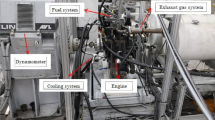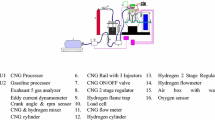Abstract
This paper shows exhaust gas recirculation (EGR) effects on multi-cylinder bi-fuel SI engine using blends of 0, 5, 10 and 15% hydrogen by energy with CNG. All trials are performed at a speed of 3000, 3500 and 4000 rpm with EGR rate of 0, 5, 10 and 15%, with equal spark timing and injection pressure of 2.6 bar. At specific hydrogen percentage with increase in EGR rate NOx emission reduces drastically and increases with increase in hydrogen addition. Hydrocarbon (HC) and carbon monoxide (CO) emission decreases with increase in speed and hydrogen addition. There is considerable improvement in brake thermal efficiency (BTE) and brake specific energy consumption (BSEC) at 15% EGR rate. At 3000 rpm, 5% EGR rate with 5% hydrogen had shown maximum cylinder pressure. Brake specific fuel consumption (b.s.f.c) increased with increase in EGR rate and decreased with increase in hydrogen addition for all speeds.















Similar content being viewed by others
Abbreviations
- BSNOx :
-
Brake specific nitrogen oxides
- BMEP:
-
Brake mean effective pressure
- BSEC:
-
Brake specific energy consumption
- BTE:
-
Brake thermal efficiency
- CO:
-
Carbon monoxide
- CNG:
-
Compressed natural gas
- EGR:
-
Exhaust gas recirculation
- HCNG:
-
Hydrogen CNG blends
- H2 :
-
Hydrogen
- HC:
-
Hydrocarbon
- IMEP:
-
Indicated mean effective pressure
- N2:
-
Nitrogen
- NOx :
-
Nitrogen oxides
- ST:
-
Spark timing
- WOT:
-
Wide open throttle
References
L.M. Das, A. Mathur, Exhaust gas recirculation for NOx control in a multi-cylinder hydrogen supplemented S.I engine. Int. J. Hydrog. Energy 18(12), 1013–1018 (1993)
P. Dimopoulos, C. Rahsteiner, Increase of passenger car efficiency with low engine out emissions using hydrogen natural mixture: a thermodynamic analysis. Int. J. Hydrog. Energy 32, 3073–3083 (2007)
A. Ochoa, H.A. Dwer, Emissions from hydrogen enriched CNG production engine, SAE 2002-01-2687
Hu Erjiang, Zuohua Huang, Experimental investigation on performance and emissions of a spark-ignition engine fuelled with natural gas–hydrogen blends combined with EGR. Int. J. Hydrog. Energy 34, 528–539 (2009)
Hu Erjiang, Zuohua Huang, Experimental study on combustion characteristics of a spark ignition engine fueled with natural gas hydrogen blends combining with EGR. Int. J. Hydrog. Energy 34, 1035–1044 (2009)
Engine Power Test Code-Spark Ignition and Compression Ignition: As Installed Net Power Rating, Surface Vehicle Standard, SAE International, IJ 1349 SEP 2011
Procedure for Mapping Performance: Spark Ignition and Compression Ignition Engines, Surface Vehicle Standard, SAE International, IJ 1312
Author information
Authors and Affiliations
Corresponding author
Rights and permissions
About this article
Cite this article
Nitnaware, P.T., Suryawanshi, J.G. Effects of Exhaust Gas Recirculation on Performance and Emission Characteristic of SI Engine using Hydrogen and CNG Blends. J. Inst. Eng. India Ser. C 100, 289–294 (2019). https://doi.org/10.1007/s40032-018-0440-z
Received:
Accepted:
Published:
Issue Date:
DOI: https://doi.org/10.1007/s40032-018-0440-z




